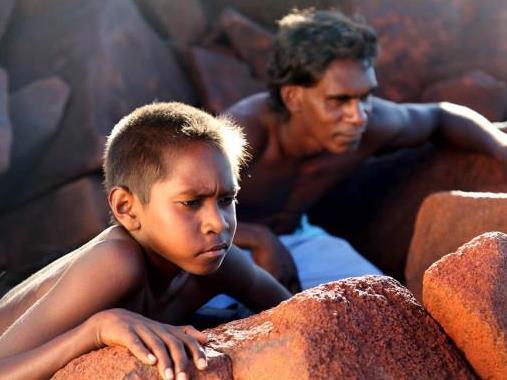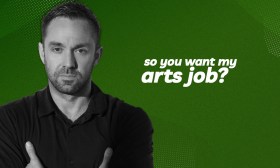Yijala Yala Project, Photo: Big hART
In Roebourne, where Big hART has been working on the Yijala Yala Project for three years, twenty-two of the young people we work with were arrested for nicking a bike at Christmas 2012…One young man a repeat offender, was recently sentenced by a judge to Big hART, to make art, music, digital comics and theatre; to tour with his elders as part of a performance piece created with his community to national arts festivals, and to make a short documentary of his efforts to bring back to court – sentenced to a cultural solution. Interesting. There were many partners in this strategy: a circle of elders, old Nannas and Aunties, government, big business, other young people, the Australia Council, arts festivals, local organisations, high-end professional artists, producers.
This young man performed the story of his community, straight from stage to policy wonks, politicians, community elders, critics and peers on one of the best stages in the country. He had never experienced a moment of success and appreciation like it. He had never been useful. He had never felt the currency and value of his story, his culture, his knowledge. He had never felt himself being appreciated. He shook the hand of then Prime Minister Julia Gillard. He flirted with her. Boasted…and went home and offended again.
The re-offending is expected, solutions unfold, they come after a series of steps back, there’s no easy salvation. It’s a process coming back from the edge, of despair, of self-harm, of criminality, of addiction, of numbness, of death, of costing the community a fortune – to participating and contributing a fortune.
His peers, friends who hang out on the bottom rung with him as part of the same project, were in Korea recently at an international comic conference, teaching high-achieving Korean kids Photoshop techniques they’d learned in Big hART workshops. High achievers, made possible by complex partnerships between unlikely groups – elders, Woodside, government, arts workers, festivals – and realised by hardcore work on the ground. These are internationally award-winning young people. They also stole a bike.
This is difficult. There is so much hubris in the community art sector: hotheads mouthing off, renaming failures as successes, avoiding scrutiny, evaluation and critique. So much of the art made under this label is deeply compromised by mediocrity. It is something of a haven for broken artists as much as for broken people participating in a project. And it can be dispiriting.
There are, of course, passionately argued reasons why work made through community processes – though it may be poor in quality – should be critiqued in different, more conciliatory ways; how these stories belong to others beyond the artist and how the process matters. This is mostly bullshit. Worthy, but bullshit. This is just artists failing the community groups they are working with. Bringing an intransigent and blocked creative practice to new settings. Jaded, hard-working community artists can be our own worst enemy. Other areas of the more refined and better-funded arts practice look on rightly with condescending smirks at our efforts.
Yet there are so many unique and important skills in CCD disciplines: new mentoring skills, empathetic skills, authenticity and flexibility, applied art techniques, community diplomacy, lobbying, insights learnt from time spent living in hard-bitten communities, having the capacity to learn from them, ignoring the government pleas to maintain the client/professional relationship and becoming friends. They contain potential new creative languages beyond the jaded offerings and creative slurry often pouring wastefully from mainstream practice – ‘great, yet another young gun taking a shot at a seagull in a Sydney subsidised theatre and shooting himself in the foot.’ What we need are new influences and disciplines, new commitments to both virtuosity and authenticity. What seems promising is a return to a deeper practice, well-funded, more centred in the whole-of-life and alongside the well-established and worthwhile models of art-making based on commodity, manufacturing and tourism.
Community arts practice is frequently encountering communities with very serious survival issues, a very low skills-base, and is attempting to achieve very big goals for multiple stakeholders, with tiny amounts of money and very little infrastructure. The arts disciplines needed are intensely difficult. They require thousands of hours of practice, and a deep pool of inter- and intra-personal skills to work in contexts where these serious and sometimes dangerous issues are played out. We often build in failure to the structures of this practice.
In this context, artists working in communities often feel defensive, behave myopically and spout dogma. People are often so burnt out and struggling with such important issues that new approaches fall on deaf ears. Ranks close. At national regional arts conferences there is an intense interest in drinking, but less interest in high-end professional development; it’s hangovers and then heads down just trying to survive.
The idea of community should be inherently collegiate and yet it is such a fraught practice, defined by scarcity, defence and dogma and the ‘right way’ of doing the work, even if that is badly. This intense and taxing creative discipline and the resulting practice is hardly even recognised as more than a sheltered workshop for artists who don’t cut it in the mainstream. Why would anyone want to work in this sector? Why would governments fund it? Yet, more and more it is coming into focus – cultural solutions are flexible, effective and cheap.
Story, when created with outsiders in our society, and told well with a deep authenticity, and placed in the right forums, can be a powerful tool for triggering new thinking. Unique benefits can be found in both the process of making, and the experience of consuming the story. If the process is deep, long, and partnership-based; if the artistry is strong; the work made with such finesse and authenticity that a shift, an illumination, an understanding is created in key audiences – portfolios, electorates, media, opinion leaders – then new, once hidden stories can be released into the narratives around which individuals, communities and the nation form. It may even be plausible to talk of cultural solutions.
This article is an edited extract from Griffith Review: Cultural Solutions available from griffithreview@griffith.edu.au.





